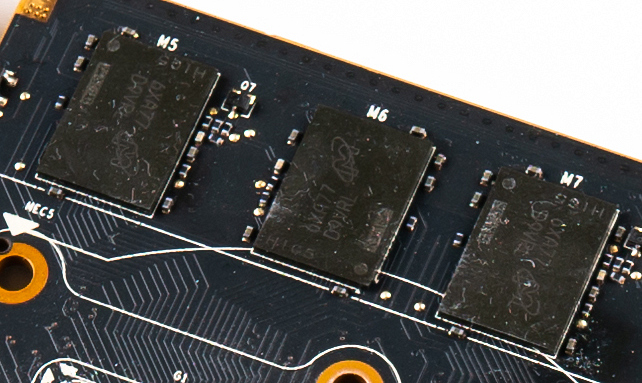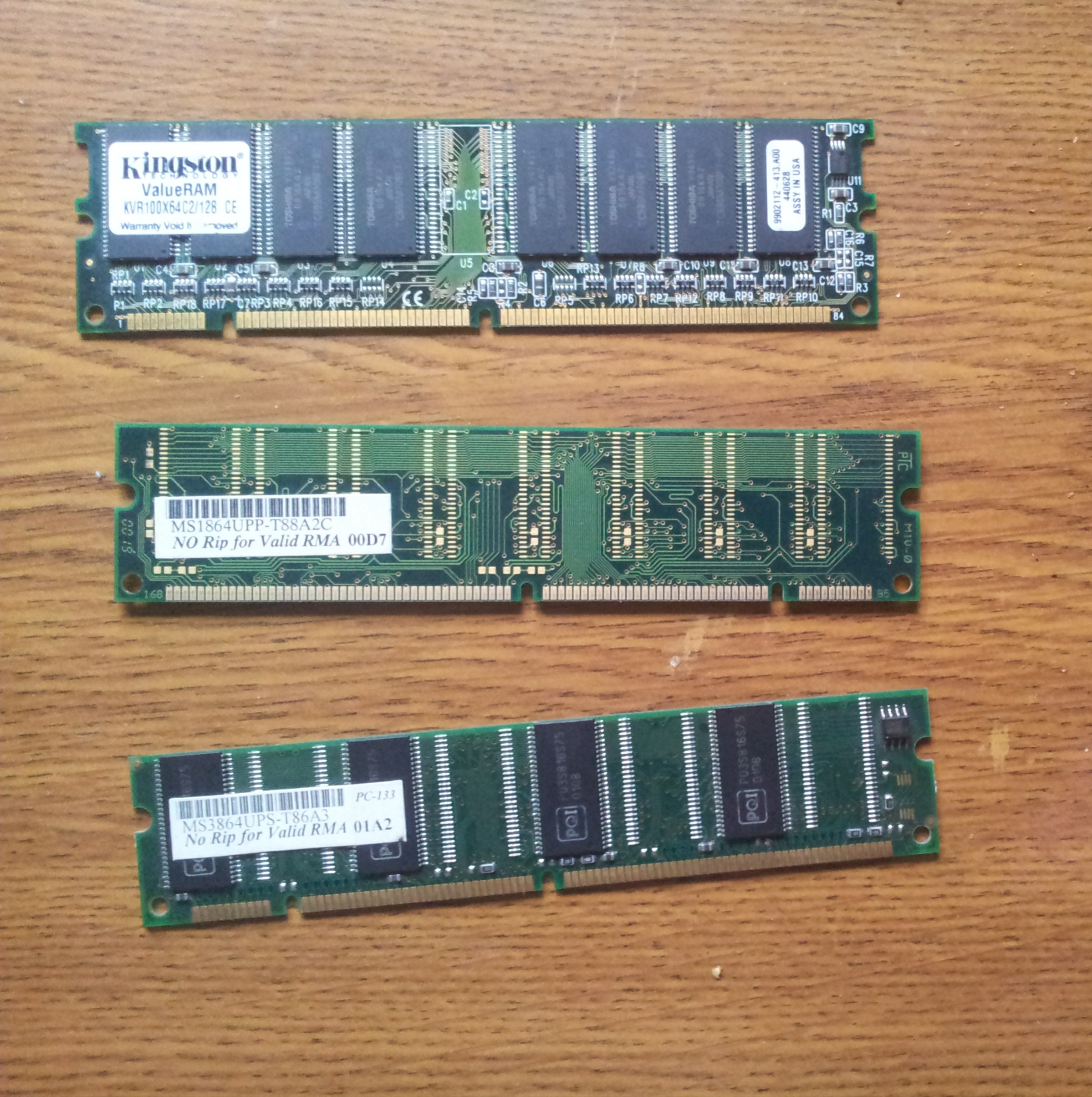|
Video RAM
Video random-access memory (VRAM) is dedicated computer memory used to store the pixels and other graphics data as a framebuffer to be rendered on a computer monitor. It often uses a different technology than other computer memory, in order to be read quickly for display on a screen. Relation to GPUs Many modern GPUs rely on VRAM. In contrast, a GPU that does ''not'' use VRAM, and relies instead on system RAM, is said to have a unified memory architecture, or shared graphics memory. System RAM and VRAM have been segregated due to the bandwidth requirements of GPUs, and to achieve lower latency, since VRAM is physically closer to the GPU die. Modern VRAM is typically found in a BGA package soldered onto a graphics card. The VRAM is cooled along with the GPU by the GPU heatsink. Technologies * Dual-ported video RAM, used in the 1990s and at the time often called "VRAM" * SGRAM * GDDR SDRAM * High Bandwidth Memory (HBM) See also * Graphics processing unit * Tiled render ... [...More Info...] [...Related Items...] OR: [Wikipedia] [Google] [Baidu] |
GDDR5X 1080ti
Graphics Double Data Rate 5 Synchronous Dynamic Random-Access Memory (GDDR5 SDRAM) is a type of Synchronous dynamic random-access memory#Synchronous graphics RAM .28SGRAM.29, synchronous graphics random-access memory (SGRAM) with a high Bandwidth (computing), bandwidth ("double data rate") interface designed for use in Video card, graphics cards, Video game console, game consoles, and high-performance computing. It is a type of GDDR SDRAM (graphics DDR SDRAM). Overview Like its predecessor, GDDR4, GDDR5 is based on DDR3 SDRAM memory, which has double the data lines compared to DDR2 SDRAM. GDDR5 also uses 8-bit wide prefetch buffers similar to GDDR4 and DDR3 SDRAM. GDDR5 Dynamic random-access memory#Synchronous graphics RAM, SGRAM conforms to the standards which were set out in the GDDR5 specification by the JEDEC. SGRAM is single-ported. However, it can open two memory pages at once, which simulates the dual-port nature of other VRAM technologies. It uses an 8N-Prefetch buff ... [...More Info...] [...Related Items...] OR: [Wikipedia] [Google] [Baidu] |
Computer Memory
Computer memory stores information, such as data and programs, for immediate use in the computer. The term ''memory'' is often synonymous with the terms ''RAM,'' ''main memory,'' or ''primary storage.'' Archaic synonyms for main memory include ''core'' (for magnetic core memory) and ''store''. Main memory operates at a high speed compared to mass storage which is slower but less expensive per bit and higher in capacity. Besides storing opened programs and data being actively processed, computer memory serves as a Page cache, mass storage cache and write buffer to improve both reading and writing performance. Operating systems borrow RAM capacity for caching so long as it is not needed by running software. If needed, contents of the computer memory can be transferred to storage; a common way of doing this is through a memory management technique called ''virtual memory''. Modern computer memory is implemented as semiconductor memory, where data is stored within memory cell (com ... [...More Info...] [...Related Items...] OR: [Wikipedia] [Google] [Baidu] |
Pixel
In digital imaging, a pixel (abbreviated px), pel, or picture element is the smallest addressable element in a Raster graphics, raster image, or the smallest addressable element in a dot matrix display device. In most digital display devices, pixels are the smallest element that can be manipulated through software. Each pixel is a Sampling (signal processing), sample of an original image; more samples typically provide more accurate representations of the original. The Intensity (physics), intensity of each pixel is variable. In color imaging systems, a color is typically represented by three or four component intensities such as RGB color model, red, green, and blue, or CMYK color model, cyan, magenta, yellow, and black. In some contexts (such as descriptions of camera sensors), ''pixel'' refers to a single scalar element of a multi-component representation (called a ''photosite'' in the camera sensor context, although ''wikt:sensel, sensel'' is sometimes used), while in yet ... [...More Info...] [...Related Items...] OR: [Wikipedia] [Google] [Baidu] |
Framebuffer
A framebuffer (frame buffer, or sometimes framestore) is a portion of random-access memory (RAM) containing a bitmap that drives a video display. It is a memory buffer containing data representing all the pixels in a complete video frame. Modern video cards contain framebuffer circuitry in their cores. This circuitry converts an in-memory bitmap into a video signal that can be displayed on a computer monitor. In computing, a screen buffer is a part of computer memory used by a computer application for the representation of the content to be shown on the computer display. The screen buffer may also be called the video buffer, the regeneration buffer, or regen buffer for short. Screen buffers should be distinguished from video memory. To this end, the term off-screen buffer is also used. The information in the buffer typically consists of color values for every pixel to be shown on the display. Color values are commonly stored in 1-bit binary (monochrome), 4-bit palettized, 8 ... [...More Info...] [...Related Items...] OR: [Wikipedia] [Google] [Baidu] |
Addison-Wesley
Addison–Wesley is an American publisher of textbooks and computer literature. It is an imprint of Pearson plc, a global publishing and education company. In addition to publishing books, Addison–Wesley also distributes its technical titles through the O'Reilly Online Learning e-reference service. Addison–Wesley's majority of sales derive from the United States (55%) and Europe (22%). The Addison–Wesley Professional Imprint produces content including books, eBooks, and video for the professional IT worker including developers, programmers, managers, system administrators. Classic titles include '' The Art of Computer Programming'', '' The C++ Programming Language'', '' The Mythical Man-Month'', and '' Design Patterns''. History Lew Addison Cummings and Melbourne Wesley Cummings founded Addison–Wesley in 1942, with the first book published by Addison–Wesley being Massachusetts Institute of Technology professor Francis Weston Sears' ''Mechanics''. Its first comput ... [...More Info...] [...Related Items...] OR: [Wikipedia] [Google] [Baidu] |
Unified Memory Architecture
A graphics processing unit (GPU) is a specialized electronic circuit designed for digital image processing and to accelerate computer graphics, being present either as a discrete video card or embedded on motherboards, mobile phones, personal computers, workstations, and game consoles. GPUs were later found to be useful for non-graphic calculations involving embarrassingly parallel problems due to their parallel structure. The ability of GPUs to rapidly perform vast numbers of calculations has led to their adoption in diverse fields including artificial intelligence (AI) where they excel at handling data-intensive and computationally demanding tasks. Other non-graphical uses include the training of neural networks and cryptocurrency mining. History 1970s Arcade system boards have used specialized graphics circuits since the 1970s. In early video game hardware, RAM for frame buffers was expensive, so video chips composited data together as the display was being scanned out ... [...More Info...] [...Related Items...] OR: [Wikipedia] [Google] [Baidu] |
Shared Graphics Memory
In computer architecture, shared graphics memory refers to a design where the graphics chip does not have its own dedicated memory, and instead shares the main system RAM with the CPU and other components. This design is used with many integrated graphics solutions to reduce the cost and complexity of the motherboard design, as no additional memory chips are required on the board. There is usually some mechanism (via the BIOS or a jumper setting) to select the amount of system memory to use for graphics, which means that the graphics system can be tailored to only use as much RAM as is actually required, leaving the rest free for applications. A side effect of this is that when some RAM is allocated for graphics, it becomes effectively unavailable for anything else, so an example computer with 512 MiB RAM set up with 64 MiB graphics RAM will appear to the operating system An operating system (OS) is system software that manages computer hardware and software res ... [...More Info...] [...Related Items...] OR: [Wikipedia] [Google] [Baidu] |
Ball Grid Array
A ball grid array (BGA) is a type of surface-mount packaging (a chip carrier) used for integrated circuits. BGA packages are used to permanently mount devices such as microprocessors. A BGA can provide more interconnection pins than can be put on a dual in-line or flat package. The whole bottom surface of the device can be used, instead of just the perimeter. The traces connecting the package's leads to the wires or balls which connect the die to package are also on average shorter than with a perimeter-only type, leading to better performance at high speeds. Soldering of BGA devices requires precise control and is usually done by automated processes such as in computer-controlled automatic reflow ovens. Description The BGA is descended from the pin grid array (PGA), which is a package with one face covered (or partly covered) with pins in a grid pattern which, in operation, conduct electrical signals between the integrated circuit and the printed circuit board (PCB) ... [...More Info...] [...Related Items...] OR: [Wikipedia] [Google] [Baidu] |
Dual-ported Video RAM
Dual-ported video RAM (VRAM) is a type of dual-ported RAM derived from dynamic RAM (DRAM), and was historically used to store the framebuffer in graphics card. Unlike conventional DRAM, VRAM features two ports: one for the CPU and one for the video display controller (VDC). This architecture allows simultaneous access—while the CPU writes data, the VDC can read it independently. This eliminates wait states ensuring smoother performance and efficient screen rendering. VRAM was widely used between the mid-1980s and mid-1990s. As newer high-performance memory technologies emerged, dual-ported VRAM was gradually phased out. Today, the term "VRAM" can refer to modern types of video memory as well, which can lead to confusion with this original dual-ported variant. History Early computers used dynamic RAM to store video data to be output to a conventional television or a simple conversion of a television that accepted composite video input. To work with such a display it is e ... [...More Info...] [...Related Items...] OR: [Wikipedia] [Google] [Baidu] |
SGRAM
Synchronous dynamic random-access memory (synchronous dynamic RAM or SDRAM) is any DRAM where the operation of its external pin interface is coordinated by an externally supplied clock signal. DRAM integrated circuits (ICs) produced from the early 1970s to the early 1990s used an ''asynchronous'' interface, in which input control signals have a direct effect on internal functions delayed only by the trip across its semiconductor pathways. SDRAM has a ''synchronous'' interface, whereby changes on control inputs are recognised after a rising edge of its clock input. In SDRAM families standardized by JEDEC, the clock signal controls the stepping of an internal finite-state machine that responds to incoming commands. These commands can be pipelined to improve performance, with previously started operations completing while new commands are received. The memory is divided into several equally sized but independent sections called ''banks'', allowing the device to operate on a memory a ... [...More Info...] [...Related Items...] OR: [Wikipedia] [Google] [Baidu] |
GDDR SDRAM
Graphics DDR SDRAM (GDDR SDRAM) is a type of synchronous dynamic random-access memory (SDRAM) specifically designed for applications requiring high bandwidth, e.g. graphics processing units (GPUs). GDDR SDRAM is distinct from the more widely known types of DDR SDRAM, such as DDR4 and DDR5, although they share some of the same features—including double data rate (DDR) data transfers. , GDDR SDRAM has been succeeded by GDDR2, GDDR3, GDDR4, GDDR5, GDDR5X, GDDR6, GDDR6X, GDDR6W and GDDR7. Generations File:ATI Radeon X1300 256MB - Hynix HY5DU561622CTP-5-5390.jpg, Hynix GDDR SDRAM File:SAMSUNG@QDDR3-SDRAM@256MBit@K5J55323QF-GC16 Stack-DSC01234-DSC01284 - ZS-retouched.jpg, A Samsung GDDR3 256MBit package File:Sapphire Ultimate HD 4670 512MB - Qimonda HYB18H512321BF-10-93577.jpg, A 512 MBit Qimonda GDDR3 SDRAM package File:SAMSUNG@QDDR3-SDRAM@256MBit@K5J55323QF-GC16 Stack-DSC01340-DSC01367 - ZS-retouched.jpg, Inside a Samsung GDDR3 256MBit package DDR SGRAM GDDR was init ... [...More Info...] [...Related Items...] OR: [Wikipedia] [Google] [Baidu] |



